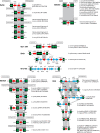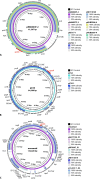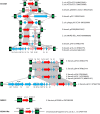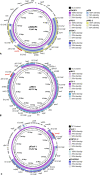Mobile Oxazolidinone Resistance Genes in Gram-Positive and Gram-Negative Bacteria
- PMID: 34076490
- PMCID: PMC8262807
- DOI: 10.1128/CMR.00188-20
Mobile Oxazolidinone Resistance Genes in Gram-Positive and Gram-Negative Bacteria
Abstract
Seven mobile oxazolidinone resistance genes, including cfr, cfr(B), cfr(C), cfr(D), cfr(E), optrA, and poxtA, have been identified to date. The cfr genes code for 23S rRNA methylases, which confer a multiresistance phenotype that includes resistance to phenicols, lincosamides, oxazolidinones, pleuromutilins, and streptogramin A compounds. The optrA and poxtA genes code for ABC-F proteins that protect the bacterial ribosomes from the inhibitory effects of oxazolidinones. The optrA gene confers resistance to oxazolidinones and phenicols, while the poxtA gene confers elevated MICs or resistance to oxazolidinones, phenicols, and tetracycline. These oxazolidinone resistance genes are most frequently found on plasmids, but they are also located on transposons, integrative and conjugative elements (ICEs), genomic islands, and prophages. In these mobile genetic elements (MGEs), insertion sequences (IS) most often flanked the cfr, optrA, and poxtA genes and were able to generate translocatable units (TUs) that comprise the oxazolidinone resistance genes and occasionally also other genes. MGEs and TUs play an important role in the dissemination of oxazolidinone resistance genes across strain, species, and genus boundaries. Most frequently, these MGEs also harbor genes that mediate resistance not only to antimicrobial agents of other classes, but also to metals and biocides. Direct selection pressure by the use of antimicrobial agents to which the oxazolidinone resistance genes confer resistance, but also indirect selection pressure by the use of antimicrobial agents, metals, or biocides (the respective resistance genes against which are colocated on cfr-, optrA-, or poxtA-carrying MGEs) may play a role in the coselection and persistence of oxazolidinone resistance genes.
Keywords: cfr; genomic island; horizontal transfer; integrative and conjugative element; mobile genetic element; optrA; oxazolidinones; plasmid; poxtA; prophage; transposon.
Figures














Similar articles
-
Various Mobile Genetic Elements Involved in the Dissemination of the Phenicol-Oxazolidinone Resistance Gene optrA in the Zoonotic Pathogen Streptococcus suis: a Nonignorable Risk to Public Health.Microbiol Spectr. 2023 Jun 15;11(3):e0487522. doi: 10.1128/spectrum.04875-22. Epub 2023 Apr 18. Microbiol Spectr. 2023. PMID: 37070987 Free PMC article.
-
Oxazolidinones: mechanisms of resistance and mobile genetic elements involved.J Antimicrob Chemother. 2022 Sep 30;77(10):2596-2621. doi: 10.1093/jac/dkac263. J Antimicrob Chemother. 2022. PMID: 35989417 Review.
-
Linezolid-Resistant Enterococcus faecalis of Chicken Origin Harbored Chromosome-Borne optrA and Plasmid-Borne cfr, cfr(D), and poxtA2 Genes.Microbiol Spectr. 2023 Jun 15;11(3):e0274122. doi: 10.1128/spectrum.02741-22. Epub 2023 Mar 30. Microbiol Spectr. 2023. PMID: 36995237 Free PMC article.
-
Detection of transferable oxazolidinone resistance determinants in Enterococcus faecalis and Enterococcus faecium of swine origin in Sichuan Province, China.J Glob Antimicrob Resist. 2019 Dec;19:333-337. doi: 10.1016/j.jgar.2019.05.021. Epub 2019 May 25. J Glob Antimicrob Resist. 2019. PMID: 31136832
-
Presence and dissemination of the multiresistance gene cfr in Gram-positive and Gram-negative bacteria.J Antimicrob Chemother. 2013 Aug;68(8):1697-706. doi: 10.1093/jac/dkt092. Epub 2013 Mar 29. J Antimicrob Chemother. 2013. PMID: 23543608 Review.
Cited by
-
Mapping the widespread distribution and transmission dynamics of linezolid resistance in humans, animals, and the environment.Microbiome. 2024 Mar 13;12(1):52. doi: 10.1186/s40168-023-01744-2. Microbiome. 2024. PMID: 38481333 Free PMC article.
-
Genomics Insight into cfr-Mediated Linezolid-Resistant LA-MRSA in Italian Pig Holdings.Antibiotics (Basel). 2023 Mar 7;12(3):530. doi: 10.3390/antibiotics12030530. Antibiotics (Basel). 2023. PMID: 36978397 Free PMC article.
-
Antimicrobial resistance and virulence potential of non-faecium and non-faecalis enterococci isolated from canine rectal swabs.Braz J Microbiol. 2025 Sep;56(3):2069-2079. doi: 10.1007/s42770-025-01717-7. Epub 2025 Jun 23. Braz J Microbiol. 2025. PMID: 40549338
-
An Optimized Screening Approach for the Oxazolidinone Resistance Gene optrA Yielded a Higher Fecal Carriage Rate among Healthy Individuals in Hangzhou, China.Microbiol Spectr. 2022 Dec 21;10(6):e0297422. doi: 10.1128/spectrum.02974-22. Epub 2022 Nov 15. Microbiol Spectr. 2022. PMID: 36377960 Free PMC article.
-
Emergence of Cfr-Mediated Linezolid Resistance among Livestock-Associated Methicillin-Resistant Staphylococcus aureus (LA-MRSA) from Healthy Pigs in Portugal.Antibiotics (Basel). 2022 Oct 19;11(10):1439. doi: 10.3390/antibiotics11101439. Antibiotics (Basel). 2022. PMID: 36290096 Free PMC article.
References
-
- Slee AM, Wuonola MA, McRipley RJ, Zajac I, Zawada MJ, Bartholomew PT, Gregory WA, Forbes M. 1987. Oxazolidinones, a new class of synthetic antibacterial agents: in vitro and in vivo activities of DuP 105 and DuP 721. Antimicrob Agents Chemother 31:1791–1797. 10.1128/aac.31.11.1791. - DOI - PMC - PubMed
-
- Brickner SJ, Hutchinson DK, Barbachyn MR, Manninen PR, Ulanowicz DA, Garmon SA, Grega KC, Hendges SK, Toops DS, Ford CW, Zurenko GE. 1996. Synthesis and antibacterial activity of U-100592 and U-100766, two oxazolidinone antibacterial agents for the potential treatment of multidrug-resistant Gram-positive bacterial infections. J Med Chem 39:673–679. 10.1021/jm9509556. - DOI - PubMed
-
- Tsuji BT, Kaatz GW, Ryback MJ. 1999. –2021. Linezolid and other oxazolidinones. In Antimicrobial therapy and vaccines volume II: antimicrobial agents. Antimicrobe, Pittsburgh, PA. http://www.antimicrobe.org/d13.asp. Accessed 12 Jan 2021.
Publication types
MeSH terms
Substances
LinkOut - more resources
Full Text Sources

